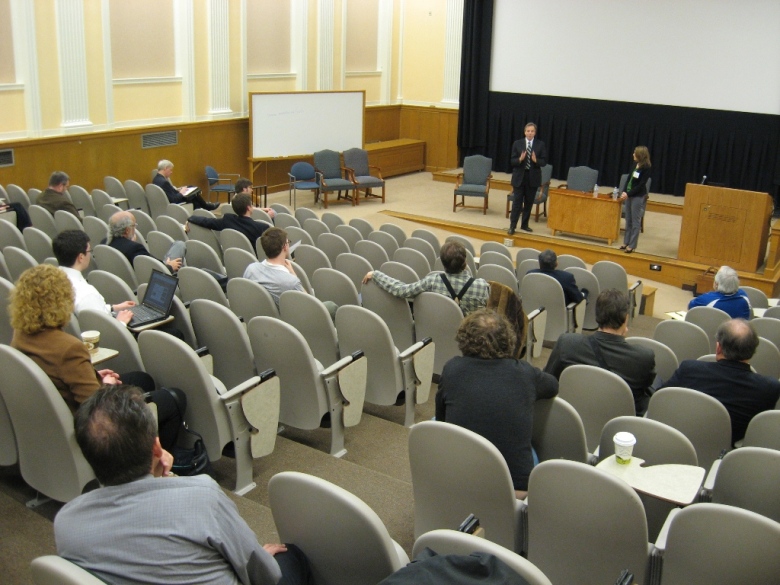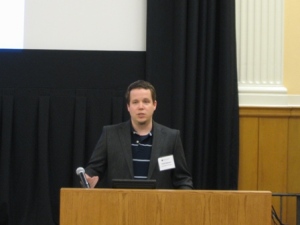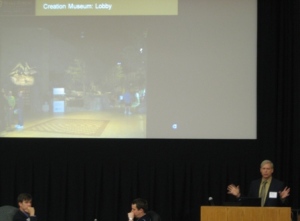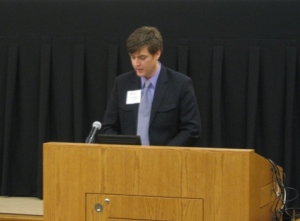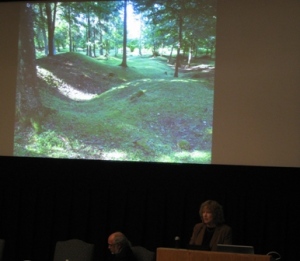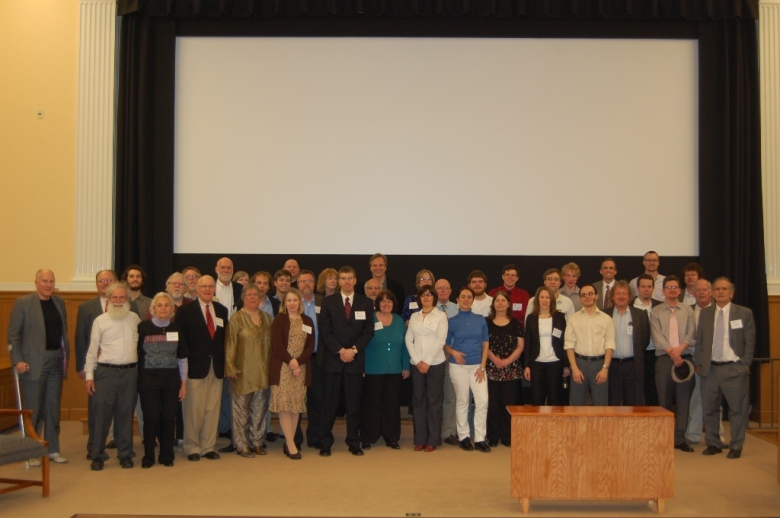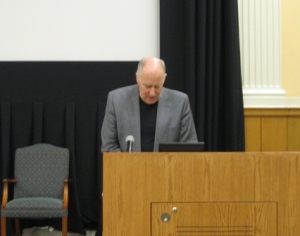The 13th Argumentation Conference is now officially over. Thanks to all the participants and the organization team.
Sunday, 9:30 – Voice, Imagination, and Argument in Commemorative Sites
March 21, 2010 — wfuarg20109:30-10:45
Keynote Address 4
Carole Blair and William Balthrop, University of North Carolina
“Voice, Imagination, and Argument in Commemorative Sites: Fleury-devant-Douaumont”
Annenberg Forum, Carswell Hall
William Balthrop
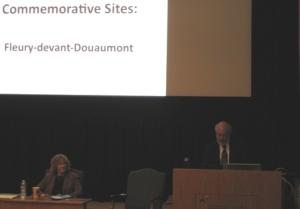 Images play a key role in many types of argument. Arguments employ both images and words. Material objects may have an even greater force.
Images play a key role in many types of argument. Arguments employ both images and words. Material objects may have an even greater force.
Commemorative sites of war are exemplars of the political collective response to triumph, defeat, unity, disunity, sacrifice etc.
The most often encountered critique of commemorative sites is that they cannot justifying, sanitizing or aestheticizing the war.
To aestheticize may mean:
- to depict as being pleasing or artistically beautiful; represent in an idealized or refined manner
- to make a subject of aesthetic consideration; view or judge with regard to an aesthetic
Fleury-devant-Douaumont is one of the 9 destroyed villages in the Verdun region in France during World War I (villages designated “Morts Pour la France”).
What does the preservation of such a site mean?
The rhetoric of Fleury-devant-Douaumont opposes a sanitization of the war
The Battle of Verdun can hardly be called a victory, even if it was not a loss
- Verdun is a symbolic site of the struggle for the liberation of France and French soldiers
- Verdun had strategic implications for all of France
- Verdun is a metonyme for the war
The 9 villages received military decorations; they each have a mayor and hold annual commemorations. Each of the 9 villages has a small mourning chapel and a Monument-aux-Morts. There are, however, differences between the villages: the extent to which they commemorate individuals or the ammount of “relics.”
Carole Blair
- It is the most visited of the 9 villages
- It is marked as a memory site, more than the others
How can it represent war without aestheticization? Fleury forces the visitor to imagine the not has happened.
Bizzare topography, even with the restoration of flora. A deeply wounded terrain. It is hardly imaginable as a result of a natural process.
Fleury’s three main streets were remapped recently, and markers of the church, blacksmith shop, town hall or the school were set throughout the place.
We can only imagine the destruction and the horrors of the war.
The chapel is tiny, but it has all the elements of a church. The monument is the same size as other monuments. They stand out because they are ordinary, but the setting is anything but ordinary.
Its remmaping implies the counter-factual: Fleury as if it had not been destroyed. Fleury has not been truly brought back to life.
It is impossible to imagine Fleury being destroyed without imagining Fleury not being destroyed or before being destroyed.
What can Fleury teach us, in its silence, about war comemoration? Its landscape is ugly and the placement of its markers portrays the war as destructive, even though the village is worthy of honor. Visitors are invited to attend not only the destruction, but also what was destroyed. That is Fleury’s rhetorical power.
Saturday, 3:30 – Argument, Debate and Democracy
March 20, 2010 — wfuarg2010Panel 7
DeTamble Auditorium, Tribble Hall
Chair
Linda Petrou, Wake Forest University
Scott Stroud, University of Texas
‘Mindful Argument, Deweyan Pragmatism, and Democracy’
Gordon R. Mitchell, University of Pittsburgh
‘Useful Frictions: Revisiting Rationales for Public Debate in a Sorted Society’
Frans H. van Eemeren and Bart Garssen, University of Amsterdam
‘Strategic Maneuvering in the European Parliament: Choosing the Line of Defense in Arguing for a Complex Audience’
1st Speaker: Scott Stroud, University of Texas
Mindful Argument, Deweyan Pragmatism, and Democracy
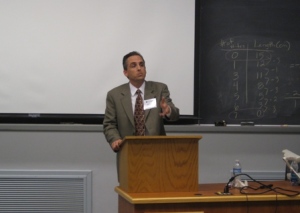 Dewey distinguishes between debate and argument:
Dewey distinguishes between debate and argument:
- Debate = winning a battle
- Argument = reasoning together
For Dewey democracy is not reduced to the process of voting, but a personal way of life. Individuals have a share and need to participate in the group they are belonging to, according to the group’s needs. At the same time, groups ought to interact harmoniously, in order to allow individuals to flourish by taking part in a variety of actions and acting accordingly with a variety of motivations.
There is also a differentiation between association and community:
- Association = physical force interaction; joint action for the interest of each individual
- Community = conjoint action; bolstering the good, minimizing the bad for everyone
Three models of arguers:
- “Rapist” = violent
- “Seducer” = deceiving
- “Lover” = honest and risk-taking
A non-mindful argument is one that non-mindfully engages the present, i.e. it does not fall pray to the temptation of separating the present from the past/future and elevating the past/future.
2nd Speaker: Gordon R. Mitchell, University of Pittsburgh
Useful Frictions: Revisiting Rationales for Public Debate in a Sorted Society
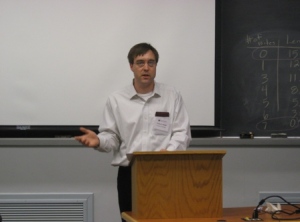 “History never repeats itself but sometimes it rhymes.”
“History never repeats itself but sometimes it rhymes.”
The rationale for public debates in the 1930s seems to echo in today’s rationale for public debates: the “more speech” remedy (speaking more about issues is the best way to “disinfect” ideas). What we see a lot today, however, is that additional rounds of dialogue prompt dynamic shifts, rather than content shifts.
The big sort: “a clustering of like-minded America is tearing us apart.” Homogeneous groups interactions tend to exacerbate violence, to polarize opinions and encourage individual to adopt more extreme versions of their existing opinions.
One example is the increasing percentage of “landslide counties” (>20% in presidential elections):
- 1970s: 26%
- 2000: 45%
- Now: 50%
If we look at Internet interactions, we can see that people are looking for echoing opinions (opinion cascading & group polarization). Groups of like-minded people will think the same, but more extreme. The harm done by frictionless spectacles (political talk-shows in the media) thus becomes apparent. Internet functions as an intellectual cul-de-sac.’
Sunstein proposes a correction in what he calls “cognitive infiltration of extremist groups”: government agents or allies openly or anonymously induce uncertainty within extremist groups.
A better solution to solve the problem of cognitive dissonance can be found in the example of students who participate in public debate from the perspective of a risk-taking, opinion-forming position. Public debate frees debaters from the clock restrictions (more generous preparation time) and allows them to genuinely engage in opinion-forming dialogue.
“Debate can clear the atmosphere.”
3rd speaker: Frans H. van Eemeren and Bart Garssen, University of Amsterdam
Strategic Maneuvering in the European Parliament: Choosing the Line of Defense in Arguing for a Complex Audience
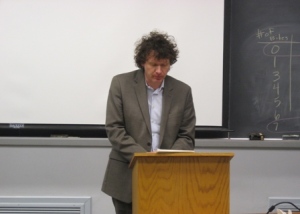 The decision process within the EU parliament is governed by a strict set of norms and sets up a complex environment for making arguments and adopting maneuvering strategies.
The decision process within the EU parliament is governed by a strict set of norms and sets up a complex environment for making arguments and adopting maneuvering strategies.
Debates in EU Parliament (EUP) are not as interesting as those in national parliaments from the media’s perspective.
Strategic maneuvering within the context of EUP is preconditioned by institutional regulations, but also by the pursuit of specific interests of political groups. Often times this calls for the use of pragmatic argumentation.
Panelists J. Anthony Blair, John Poulakos, David Coates
March 20, 2010 — wfuarg2010Chair
Craig Allen Smith, North Carolina State University
__________________________________________________________________________________
J. Anthony Blair, University of Windsor, Canada
‘The Ethics of Argumentation’
Guiding question: Are there moral norms associated with the activity of argumentation?
Three possibilities:
(1) moral normativity
(2) non-normativity
(3) non-moral normativity
We are all familiar with roles in communication (e.g., the repeator, the hog, the interrupter, the open-door pusher). These people don’t exhibit moral failings, they exhibit lack of etiquette.
One metaphor to ethics in argumentation may be the moral norms of business and medical ethics (e.g., beneficence)
Argumentation is a purposeful activity premised on achieving some objective.
In argumentation it is unethical to use grounds you believe to be false, unethical to deliberately impy fallacious arguments and unethical to deliberately overstate the epistemic standing of your claims.
___________________________________________________________________________________
John Poulakos, University of Pittsburgh
‘The Adversaries, the Discussants, and the Disappointed Lover: Three Dramatic Modes of Argument in Plato’
Guiding issue: Well known antagonism between philosophy of rhetoric.
We should read the ways in which Plato displays arguments in action, rather than his more direct statements about argumentation. Plato can be read in two ways:
(1) As a straight laced logician interested in rationality of arguments
(2) As a playwright concerned with the integrity of story
Regardless of how we read him, Plato can also be read in one of two modes:
(1) Within (i.e., within a single work)
(2) Across (i.e., a single theme treated throughout several or all works)
Studies of Plato today highlight two works only, the Gorgias and Phaedrus. This is a confined approach to examining Plato’s understandings of philosophy and rhetoric. Plato is too expansive to be confined to two works, moreover how he deals with rhetoric extends far beyond merely the Gorgias and Phaedrus.
Three works (Gorgias, Protagorus, and Symposium), taken consecutively, explicate rhetoric in action.
In reading these texts as demonstrations, (1) dialectical argumentation has its limitations, (2) “good discussion” is when cooperation leads to satisfaction and dissatisfaction for both sides of discussion (rather than traditional agonism, which indicates one winner and one loser), and (3) Plato’s argument as merely to destroy rhetoric is severely limited.
___________________________________________________________________________________
David Coates, Wake Forest University
‘Answering Back: Liberal Responses to Conservative Arguments’
Discusses recent book, “Answering Back,” its form, content, and critical conversation in which it is a part.
(1) Format: a living, democratic, fighting book.
What is a living book? A book and blog whose author regularly updates and recontextualizes chapters in book with emergent data. What is a democratic book? Represents the liberal responses and conservative alternatives of genuine bipartisanship, raising the quality of political debate. What is a fighting book? Outlines the many resources needed to defend in 2010 the progressive political space won in 2008.
(2) Content:
If simple terms speak to the American public (evidenced by corporate and financial support in the public sector, such as Fox News), how do we (i.e., liberalism, political progressivism) communicate complex ideas in simple terms?
Theoretical work in rhetoric and argumentation are absolutely necessary to public debate.
Saturday, 2:00 – Making the case for argumentation practices in education
March 20, 2010 — wfuarg2010Carol Winker, Georgia State University
‘Impacting Argumentation Studies’
Annenberg Forum, Carswell Hall
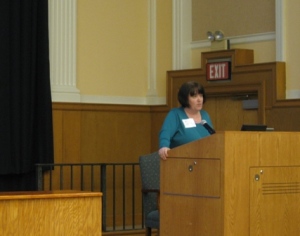 Carol Winkler gave a presentation on the importance and potential impact of the field of humanities on the general education of middle school students and on society. Drawing from the results of an urban league debate program implemented in middle school, the presentation made the case for defending the relevance of humanistic education within a context that increasingly challenges it.
Carol Winkler gave a presentation on the importance and potential impact of the field of humanities on the general education of middle school students and on society. Drawing from the results of an urban league debate program implemented in middle school, the presentation made the case for defending the relevance of humanistic education within a context that increasingly challenges it.
How do we present the value of our field to the outside world? A model may be offered by a program that has had quantifiable beneficial effects on school performance and attendance, has been acknowledged by local and national administrative actors and has managed to bring together two seemingly different areas of education (competitive debate and “drop-out students”).
Step 1: Address societal problems
- school drop out
- ability gap (e.g.reading)
- violence
Step 2: Identify key partners committed to addressing the problem
- CAD partners: universities, housing authority, urban debate league, public shcool system, community supporters, law enforcement
- students tell us what they want to learn instead of our instilling with them what we want to teach
Step 3: Identify and include partners’ values when constructing your research agencies
Step 4: Present research findings in ways readily accessible to the audience
- administrators
- policy-makers
Step 5: Have those impacted validates the results
- interviews from CAD participants and their parents
Step 6: Have partners testify about your effectiveness and the results of the program
Step 7: Present your research to decision-makers concerned about your identified problem
Group Picture
March 20, 2010 — wfuarg2010Saturday, 11:00 – Argumentation and Health
March 20, 2010 — wfuarg2010Panel 4
Argumentation and Health. Overcoming a Less-than-ideal Interactional Paradigm
DeTamble Auditorium, Tribble Hall
Chair
Frans van Eemeren, University of Amsterdam
Sara Rubinelli, Jerome Bickenbach and Gerold Stucki, University of Lucerne and Swiss Paraplegic Research, Nottwil, Switzerland
‘Realism and Nominalism: Argumentative Consilience in Doctor-Patient Communication’
Nancy Green, University of North Carolina at Greensboro
‘Biomedical Argumentation: The Challenge of Uncertainty’
Peter J. Schulz, Virginia Tech
Kent Nakamoto, Virginia Tech, University of Lugano
and Dima Mohammed, University of Amsterdam, Virginia Tech
‘Audience Adaptation in Direct-To-Consumer Advertising’
The common thread tying the presented papers in “Argumentation and Health: Overcoming a Less-than-Ideal Interactional Paradigm” is the lack in the medical field’s ability to communicate with patients (whether regarding diagnoses, treatments, etc). All seem to agree there needs to be more patient involvement, more patient education, and the need to fix the argumentation strategies when convincing patients of the best medical treatment available.
Nancy Green’s presentation focused on ways to combat uncertainty in health communication, especially when communicating health risks to patients. Her paper mainly focuses on a critique of Walter et al.’s model of causal argumentation. She suggests a model with more medicine-related critical questions.
Sara Rubinelli’s presentation focused on ways to fix the intrinsic problems in medical practices and diagnoses. She uses Aristotle’s rhetoric to evaluate the doctor-patient relationship, particularly in doctor-patient consultations. She notes the problem arises when there’s a disagreement between doctor and patient in regard to the best possible medical treatment. We need to fix argumentation strategies in these consultations as opposed to possibly changing practices.
The presented paper of Dina Mohammed, Peter J. Schultz’s entitled “Audience Adaptation in Direct-to-Consumer Advertising Framework of the concept of Strategic Maneuvering” discusses how pharmaceutical companies adapt advertisements to consumers. The standard belief is that pharmaceutical companies do not educate or inform because they contain emotional appeals in order to target potential consumers. In their paper, Mohammad and Schultz note that pharmaceutical companies are strategic when choosing topics used in their advertising arguments. In the end, they conclude that it’s possible for pharmaceutical advertising to fulfill educational and promotional purposes; however, advertising tends to appeal to potential consumers rather than actual patients.
Saturday, 11:00 – Scientific argument, narrativizing science, mixing scientific and religious discourse
March 20, 2010 — wfuarg2010Panel 5
Annenberg Forum, Carswell Hall
Chair
Andrew Leslie, Salem College
Rachel Avon Whidden, Lake Forest College
Margaret D. Zulick, Wake Forest University
‘Analytic under Siege: Stealth Dialectics and Rhetorical Deligitimation of Scientific Argument in the Public Sphere’
Atilla Hallsby, University of Iowa
‘Narrativizing Science and Disaster: Story, Discourse, and Possible Worlds in the Supercollider’
Paper read by Liviu Gajora, Wake Forest University
Kelly Congdon, University of Richmond
‘From Expressivist Swords to Deliberative Ploughshares? Mixing the Language of Jesus and Genes and the Constitution of Controversy over Evolution’
1st speaker: Rachel Avon Whidden, Lake Forest College; Margaret D. Zulick, Wake Forest University
Analytic under Siege: Stealth: Dialectics and Rhetorical Deligitimation of Scientific Argument in Public Sphere
 The idea that science should not have an agenda of its own leads to a deligitimation of science when the agendas are revealed.
The idea that science should not have an agenda of its own leads to a deligitimation of science when the agendas are revealed.
Slide showing overlapping ground of Analytic, Dialectic and Rhetoric each with distinct functions relative to one another. Dialectic, in part to refine the analytic, Rhetoric shifts between the other two. The rhetorical voice allows analytical and dialectic to represent themselves in the public sphere.
Rhetoric is, according to Aristotle, the counter part of Dialectic. Science, the analytical, and ideology, the dialectic can be mediated through
MMR and autism, vested interest in claim that Wakefield put forth in the Lancet that there is a link between the two based upon a few parental claims. Wakefield was contracted by an attorney to investigate what Wakefield had already “determined”, that there was a link between the two. Wakefield was found guilty of multiple scientific misconduct 12 years latter. However, CNN reports and others insist that the scientific community is involved in a conspiracy–they do not want to open up the “can of worms.” Passions regarding anecdotal sufferings of parents.
Intelligent design, a dialectic, masquerades as an analytic.
Deliberate attempt to disprove existing science and to colonize the realm of science within the classroom.
Questions will follow all papers.
2nd speaker: Atilla Hallisby (paper presented by Liviu Gajora)
Narrativizing Science and Disaster: Story, Discourse, and Possible Worlds in the Supercollider
The Large Hadron Collider (LHC) received attention early in its planning stage of dystopic (and apocalyptic) warnings, that did not occur according to predicted dates. Shortly after the LHC was started, it suffered a massive failure upon its maiden run requiring shut down and reconstruction of a significant portion of the LHC.
Logics provided by the technical community do not carry sufficient weight to dislodge the dystopic narrative or variants. Especially when some scientists discussed the possibility that the LHC might produce blackholes that could swallow the matter around them.
After the failure, the narrative surfaced that particles traveled back in time to destroy the LHC.
The distinction between the fictional and the non-fictional risks becoming purely phenomenological. Much like in Culler’s deconstruction of Russian Formalism notions of sjuzhet and fabula (corresponding to notions of story and plot), the fact that a story can be true is sometimes as important as the fact that the story is true (things found in the story actualy happened). Freud illustates a similar idea when saying that psycnoanalysis works to the same extent if the story the patient says actually happened or just thinks happened.
Scientific discourse cannot rely on facts, because there are none (the LHC provided neither the Higs-Boson particle, nor the end of the world), thus it is forced to rely on narratives that have an internal logic, even though their external logic cannot be verified. Within this framework, public (non-technical) fictional narratives can compete directly with the scientific narratives, because a causal relationship is impossible to support with real world evidence.
3rd speaker: Kelly Congdon, University of Richmond
From Expressivist Swords to Deliberative Ploughshares? Mixing the Language of Jesus and Genes and the Constitution of Controversy over Evolution
 Argument as warfare, reduces to two sides and often induces apathy in those uncomfortable with argumentative methods.
Argument as warfare, reduces to two sides and often induces apathy in those uncomfortable with argumentative methods.
Collective deliberation stands against the argumentation methodology so constitutive of our public debate.
Enter Francis Collins ‘The Language of God: A scientist presents evidence for belief’. Presidential honor, Christian accolades as single most influential contribution to Christian apologetics.
Sam Harris one of Dawkins’ followers on other extreme, critiques Collins: ‘Collins proves that a stellar career as a scientist is not guarantee of being a follower of scientific principles.
Claim that raising your children to be religious as child abuse.
To the public it appears that a choice must be made between either two, false dilemma.
Reviews of Harris’s book–ammunition to arm secularists.
Harris’s book will be read mostly by scientists.
Collins’ deliberative engagement of the subject is tha appeal of Colllins’ book.
Respectful and charitable listening across beliefs.
Rational and irrational polarization precludes a wide range of alternates. Leaving only a scorched earth methodology on each side.
Certain rhetors cordon off communities–those in the middle must choose or “run for your life.”
Fundamentalism a spongable style and system of tropes.
Panel now open for questions.
Saturday, 9:30 – Giving Contextualization its Rightful Place in the Study of Argumentation
March 20, 2010 — wfuarg2010Keynote Address 2
Frans H. van Eemeren, University of Amsterdam
‘In Context. Giving Contextualization its Rightful Place in the Study of Argumentation’
Annenberg Forum, Carswell Hall
The busiest day of the Conference just started with Frans Eemeren’s keynote address on the importance of context and macro-context in the analysis of the soundness of arguments in communicative activities.
A reconstructive analysis of the argumentative discourse leads to reconstructive transformations:
- Leaving out all speech that does not play a part in the resolution
- Rearranging in an insightful way those elements whose order does not help
- Making explicit all arguments that are implicit
- Reformulating in a meaningful way things that lead to resolution
Only after these transformations have been applied, can we proceed to the evaluation of the discourse.
Analysts have various sources:
- The text
- The context
- The macro-context
- Background information
Context is not fixed: with every new argument, the context is changed.
The macro-context focuses on the inter-textual, the other speech events.
Walton introduces the notion of “dialogue types,” each of them having specific soundness norms. The usefulness of dialogue types is to account systematically for the variance of the criteria for identifying fallacious argumentation. Each dialogue type yields a separate norm of argumentation, with specific rules as to when arguments are sound and when they are fallacious. The problem with this paradigm is that certain instances involve more than one dialogue type. Also, whenever there is a dialectic shift (a change from one dialogue type to another in the course of a discourse), it is hard to make the distinction between a licit and an illicit dialectic shift (the latter being a fallacy).
Argumentation is not just a theoretical construct, but an empirical phenomenon observed in communicative practices. Speech events are analyzed as tokens of specific communicative activity type (CAT). Not all CAT are argumentative, but arguments are usually a big part of any CAT. A list of CATs can be empirically compiled, a list that is bound to be incomplete.
Within this framework, a fallacy can be defined as a move that is prejudicial or harmful on the realization of the goal of the CAT.
How do we distinguish between sound and fallacious moves in CATs? Fallacies judgments should be contextual judgments. Has any dialectical norm been violated in this particular context? Let’s take the example of the appeal to authority. Its validity depends on the rules of the CAT. Appeal to a dictionary in a game of scrabble, where the macro-context provided a tacit agreement that the dictionary is the deciding tool when in doubt, is a valid type of argument. Soundness criteria vary from field to field.
In analyzing and evaluating argumentative discourses, we need to take into account the constraints imposed on strategic maneuvering attempts by the macro-context of institutionalized norms of CATs.
